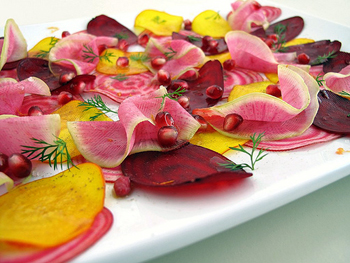 I confess, I couldn’t live without onions - maybe if I was marooned on an uninhabited tropical island and there was literally ‘nothing’ to slow cook or even firewood [I suppose] I would have to adapt. No other vegetable makes me happier then local onions - it is my favorite. All the different varieties have separate flavors and I love to do different thing with each variety from Ailsa Craig to Walla Wallas.
I confess, I couldn’t live without onions - maybe if I was marooned on an uninhabited tropical island and there was literally ‘nothing’ to slow cook or even firewood [I suppose] I would have to adapt. No other vegetable makes me happier then local onions - it is my favorite. All the different varieties have separate flavors and I love to do different thing with each variety from Ailsa Craig to Walla Wallas.
The first onion of the season is always baked whole with a knob of butter, a few tablespoons of maple syrup and wrapped in foil or parchment paper. I slow bake the onion parcel at 325 degrees F for at least and hour and a half-you will know when it is done when the aroma makes its way all the way to the other side of your house. How is that for precise recipe writing?
After I’ve eaten my first baked onion of the season with a spoon I can relax and get a bit more creative. Did I mention I encourage my onion farmers to leave the green tops on? They think I’m a little daft to pay for the extra weight only because they have never baked one of their onions split in two, covered with a touch of stock and baked in a covered dish until it is tender and very little liquid is left. I pour a little heavy cream over the top along with its distant cousin, chopped chives and reduce the cream until thick-ish. Any variety of onion works - red onions will tint the cream a delicate rose color.

 Is there another name as fun to say as "kumquat"? Yes. Lemonquat, limequat, and orangequat (also called mandarinquat). I didn't make these up; they are citrus hybrids -- part kumquat and part lemon, lime, or orange, respectively.
Is there another name as fun to say as "kumquat"? Yes. Lemonquat, limequat, and orangequat (also called mandarinquat). I didn't make these up; they are citrus hybrids -- part kumquat and part lemon, lime, or orange, respectively. As soon as the new year arrives, January becomes the month all about weight loss, getting fit, eating healthy, etc. We all put on the extra pounds during the holiday months by eating our favorite hearty comfort foods and then try to shed them as fast as we can. Just like everyone else, I too make a new year's resolution I don't quite keep. But this year I hope to follow through with my plan to eat more and more vegetables and a lot less meat. My way of eating during the winter months has always included lots of soups and stews that feature meat. But I'm finding that once I change the foods I eat and the techniques I use to cook them, that I can follow through with my plan. To achieve this, I try to think of the foods of summer, such as salads, grilled chicken and fish, and other recipes that remind me of healthier eating.
As soon as the new year arrives, January becomes the month all about weight loss, getting fit, eating healthy, etc. We all put on the extra pounds during the holiday months by eating our favorite hearty comfort foods and then try to shed them as fast as we can. Just like everyone else, I too make a new year's resolution I don't quite keep. But this year I hope to follow through with my plan to eat more and more vegetables and a lot less meat. My way of eating during the winter months has always included lots of soups and stews that feature meat. But I'm finding that once I change the foods I eat and the techniques I use to cook them, that I can follow through with my plan. To achieve this, I try to think of the foods of summer, such as salads, grilled chicken and fish, and other recipes that remind me of healthier eating. Eat your beets! We've all heard that from our moms quite often as kids. Unfortunately it was more often canned beets that we were persuaded to eat. As a curious eater, I've come to appreciate beets in many different preparations. I especially love them roasted in salads. But have you ever thought of eating them raw? Sliced very thinly, beets and other root vegetables, make great salads. Yes, it's possible to slice them thin with a knife, but a mandoline does the job better than anything else to get paper-thin shavings.
Eat your beets! We've all heard that from our moms quite often as kids. Unfortunately it was more often canned beets that we were persuaded to eat. As a curious eater, I've come to appreciate beets in many different preparations. I especially love them roasted in salads. But have you ever thought of eating them raw? Sliced very thinly, beets and other root vegetables, make great salads. Yes, it's possible to slice them thin with a knife, but a mandoline does the job better than anything else to get paper-thin shavings. My love for Meyer lemons continues this week with another dish using these amazingly flavorful citrus fruits. This time it's a pasta dish that's done in less than 15 minutes. It's meatless, so it's great for vegetarians. But the savory flavors of garlic and crushed red pepper will also appeal to the meat-and-potatoes guys. But what really lifts this dish is the Meyer lemons, which add a tantalizing zing that refreshes the palate.
My love for Meyer lemons continues this week with another dish using these amazingly flavorful citrus fruits. This time it's a pasta dish that's done in less than 15 minutes. It's meatless, so it's great for vegetarians. But the savory flavors of garlic and crushed red pepper will also appeal to the meat-and-potatoes guys. But what really lifts this dish is the Meyer lemons, which add a tantalizing zing that refreshes the palate.
